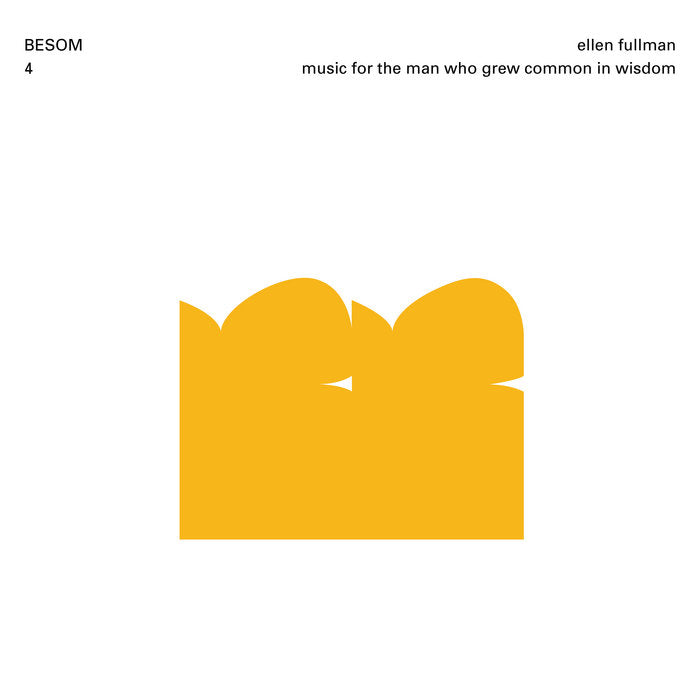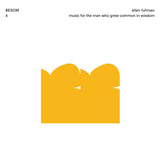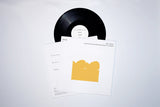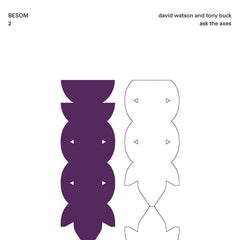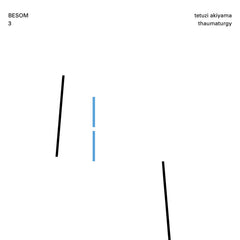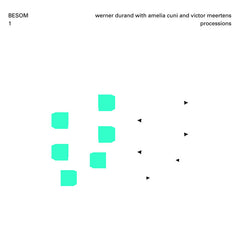ellen fullman // music for the man who grew common in wisdom LP
- Availability:
アメリカの実験音楽家ellen fullmanが、2020年にアメリカ・LAの実験/ドローンレーベルBesom Presseからリリースしたレコードです。
長いワイヤーを使用した作品が有名な彼女ですが、本作ではガラスや木屑、水などを使用した演劇用に制作した2曲を収録。 DLコード付属。
以下、レーベルによる解説です。
"besom presseは、ellen fullmanの『Music for the Man Who Grew Common in Wisdom』を発表する。彫刻的なロング・ストリングス・インストゥルメント(LSI)で知られるellen fullmanだが、このムジーク・コンクレートの作品では、ellen fullmanのサウンド探求の、あまり知られていない一面を披露している。2つの広大な作品の中で、ellen fullmanは、コミカルなもの、威嚇的なもの、そして至福的なものの中を旅し、彼女が広く賞賛されているユニークな運動性と音色の美学を呼び起こす。テキサス州オースティンに住んでいた1987年から1989年にかけて作曲されたこの音楽は、もともと振付家デボラ・ヘイの同名のダンス作品の伴奏として使われた。besom presseからのリリースは、全曲の最後の2楽章を収録している。
1985年、ジャドソン・ダンス・シアターの創設メンバーであるヘイが、ellen fullmanに新作の共同制作を依頼した。ヘイは、マース・カニングハム・ダンス・カンパニーのメンバーとしての経験や、ジョン・ケージとカニングハムのコラボレーションのあり方に深く影響を受けていた。そのため、ellen fullmanの音楽と振付の間に予定されていた関係はタイミングだけだった。ヘイの自由闊達なアプローチに触発され、新しい音楽道具を使うことを奨励されたellen fullmanは、次のように説明した。「批判されないとわかっているから、不条理に対する自分の魅力を自由に掘り下げることができた。」 様々なアコースティック音源を使った『Music for the Man Who Grew Common in Wisdom』では、ellen fullmanはProphetサンプラーの可能性を追求している。このツールの使用経験について、彼女はこう説明する: 「Prophetで何ができるかに魅了され、以前、オープンリールのテープレコーダーを使っていたムジーク・コンクレート・アプローチからの発展ともいえる方法で仕事をした。
本作の最も興味深い文脈的側面のひとつは、この作品が制作された時の流動的な状況である。LSIの知識を深めることに多くの時間とエネルギーを捧げた後、最近、移転し、使い慣れない機材を使用したこのレコードは、ellen fullmanの作曲家としての旅路の超レアなスナップショットを提供している。
この小旅行は、注意深く繰り返し聴くことができる。その音楽的な出来事は、詩的なものと無感動なものとの間の稀有なバランスを保ちながら、自然にやってくる。この作品は、そのテクノロジーによってタイムスタンプが押されているが、過去の多くの斬新なリリースを当惑させるような古めかしさはない。Music for the Gardener(庭師のための音楽)』と題されたA面では、コンクリート板の上に落とされたガラスの破片、吊るされた木屑の穏やかな音、前後に揺れる水、そして彼女自身の声など、様々なありふれた音源から絶妙に録音された音響の数々をトリガーとしている。作品は、半音階的に配置されたガラスから始まり、ellen fullmanは一連の和音形から個々の音をトリガーして、遊び心たっぷりに即興演奏する。チャイムとバウンスは、レンガの壁に突き刺さる6本パックのように、突然のクラスター・コードで中断される。これは、ガラス・サンプルの氷のようなデジタル・エイリアシングに寛大な音の箔を与える。再びフォーカスを移すと、バスタブの中の水の音がハイファイで再生され、バスタブの両端に配置されたマイクによって、目のくらむような広いステレオフィールドで聴こえる。サンプリングされたフルマンの声は、瞑想的なモーダル・メロディーを奏で、カランカランと鳴る木のリズムに支えられたコーダのようなものを意味する。
サイドBの『Music for the Aviator』は、デボラの指令に根ざしている。ホドロフスキーの『サンタ・サングレ』に代わるサウンドトラックのように、スターターガン、泡、歓声、カリオペ・オルガンが、サーカスでのリゼルギーな一日を思い起こさせる。多かれ少なかれ、突然の騒動が随所で起こる。サーカスは鯨類の吹き穴の音に飲み込まれ、その音はバ・ベンゼレ・ピグミー音楽のヒンデウーの笛のようなもの(ハービー・ハンコックの『ウォーターメロン・マン』のイントロを思い浮かべてほしい)へとフェードアウトしていく。やがてこの作品は、倍音のスペクトルがぎっしり詰まった音が湧き出る一方で、うっすらとした声のループの雲の中に置かれた、調律された息の音の満足のいくリズムのパルスに落ち着く。
『The Man Who Grew Common In Wisdom』は2019年8月、ベルリンのTanz im August Festivalで開催された「RE-Perspective Deborah Hay, Works from 1968 to the Present」で上演された。ストックホルムのクルベリ・バレエ団のエヴァ・モーンがソリストを務め、この作品は彼らのレパートリーの一部となった。"
レーベルその他作品はこちら /// Click here to see more besom presse releases available at Tobira.
----------------------
Includes DL code. 12" black vinyl.
Tracklist:
- the gardener 17:48
- the aviator 22:10
besom presse:
"besom presse announces the release of Ellen Fullman’s Music for the Man Who Grew Common in Wisdom. Known prominently for her sculptural Long String Instrument (LSI), these musique concrete pieces showcase an underrecognized side of Fullman’s sound investigations. In two expansive works, Fullman voyages through the comic, the menacing and the blissful all while evoking the unique kinetic and timbral aesthetic for which she is widely praised. Composed between 1987-1989, while living in Austin, Texas, the music originally served as accompaniment to choreographer Deborah Hay's dance piece of the same name. The besom presse release presents the last two movements of the full composition.
In 1985, Hay, a founding member of the Judson Dance Theater, commissioned Fullman to collaborate on a new work. Hay was deeply influenced by her experience as a member of the Merce Cunningham Dance Company and to the way John Cage and Cunningham collaborated. As such, the only relationship planned between Fullman’s music and the choreography was timing. Inspired by Hay’s open-ended approach and encouraged to use a new set of musical implements, Fullman explained, “I found this way of working to be remarkably refreshing and respectful of my process. I felt free to delve into my attraction for absurdity, knowing that I would not be judged.” With a variety of acoustic sound sources, Music for the Man Who Grew Common in Wisdom finds Fullman exploring the possibilities of the Prophet sampler. Describing her experience of using this tool she explains: “I was fascinated by what could be done with the Prophet and worked in a way that could be seen as an outgrowth from the musique concrete approach that I had used with a reel-to-reel tape recorder in earlier years.”
One of the most interesting contextual aspects of Music for the Man Who Grew Common in Wisdom is the flux under which it was created. Recently relocated and using unfamiliar equipment after having dedicated so much of her time and energy to advancing her knowledge of the LSI, this record provides an ultra-rare snapshot of Fullman’s journey as a composer: a suspended moment wherein her earlier phase of sound collaging comes into direct contact with her sensibilities of movement and sound as refined by her work with the LSI.
The excursion rewards careful, repeated listening. Its musical events arrive spontaneously while striking a rare balance between the poetical and unaffected. While the work is time-stamped by its technology, it evades the quaintness that beleaguers so many novel releases from the past. On side A, titled Music for the Gardener, Fullman triggers an assortment of exquisitely recorded acoustic sounds from a variety of quotidian sources including bits of glass dropped on a concrete slab, the gentle clanking of suspended woodscraps, water swishing back and forth, and her own voice. The piece begins with the glass, arranged chromatically, which Fullman playfully improvises with by triggering individual notes from a series of chord shapes. The effervescent chime and bounce is punctuated with sudden cluster chords that explode like a six-pack against a brick wall. This gives way to the round and muted tones of the swinging timber—a generous sonic foil to the icy digital aliasing of the glass samples. Shifting focus again, we hear the hi-fi swishing of water in a tub reproduced in a dazzlingly wide stereo field made possible by microphones arranged at either end of the bath. Fullman’s sampled voice, played in a meditative modal melody, signifies a kind of coda anchored by the rhythmic pulsing of clanking wood.
Side B’s Music for the Aviator is rooted in Deborah’s directive: "We contain the mystery, but we don't know what it is." Like an alternative soundtrack to Jodorowsky’s Santa Sangre, starter guns, percolating bubbles, cheering crowds, and a calliope organ conjure a lysergic day at the circus. More or less abrupt disturbances take place throughout. The circus is consumed by cetaceous blowhole sounds, which in turn fade into something vaguely like the Hindewhu whistle of Ba-Benzélé Pygmy music (think the intro to Herbie Hancock’s Watermelon Man). Eventually the piece settles into a satisfying rhythmic pulse of tuned breath sounds set in a cloud of woozy voice loops while a tightly packed spectrum of overtones springs forth.
The Man Who Grew Common In Wisdom was performed in August 2019 at the Tanz im August Festival, Berlin, in their RE-Perspective Deborah Hay, Works from 1968 to the Present. Eva Mohn of the Cullberg Ballet, Stockholm, was the soloist, and the work has become part of their repertoire. Music from the first movement of this piece, The Navigator (aka “Staggered Stasis”), was made available earlier this year by Superior Viaduct on a reissue of Fullman's 1987 self-released cassette, In The Sea.
"
Artist : ellen fullman
Label : besom presse
アメリカの実験音楽家ellen fullmanが、2020年にアメリカ・LAの実験/ドローンレーベルBesom Presseからリリースしたレコードです。
長いワイヤーを使用した作品が有名な彼女ですが、本作ではガラスや木屑、水などを使用した演劇用に制作した2曲を収録。 DLコード付属。
以下、レーベルによる解説です。
"besom presseは、ellen fullmanの『Music for the Man Who Grew Common in Wisdom』を発表する。彫刻的なロング・ストリングス・インストゥルメント(LSI)で知られるellen fullmanだが、このムジーク・コンクレートの作品では、ellen fullmanのサウンド探求の、あまり知られていない一面を披露している。2つの広大な作品の中で、ellen fullmanは、コミカルなもの、威嚇的なもの、そして至福的なものの中を旅し、彼女が広く賞賛されているユニークな運動性と音色の美学を呼び起こす。テキサス州オースティンに住んでいた1987年から1989年にかけて作曲されたこの音楽は、もともと振付家デボラ・ヘイの同名のダンス作品の伴奏として使われた。besom presseからのリリースは、全曲の最後の2楽章を収録している。
1985年、ジャドソン・ダンス・シアターの創設メンバーであるヘイが、ellen fullmanに新作の共同制作を依頼した。ヘイは、マース・カニングハム・ダンス・カンパニーのメンバーとしての経験や、ジョン・ケージとカニングハムのコラボレーションのあり方に深く影響を受けていた。そのため、ellen fullmanの音楽と振付の間に予定されていた関係はタイミングだけだった。ヘイの自由闊達なアプローチに触発され、新しい音楽道具を使うことを奨励されたellen fullmanは、次のように説明した。「批判されないとわかっているから、不条理に対する自分の魅力を自由に掘り下げることができた。」 様々なアコースティック音源を使った『Music for the Man Who Grew Common in Wisdom』では、ellen fullmanはProphetサンプラーの可能性を追求している。このツールの使用経験について、彼女はこう説明する: 「Prophetで何ができるかに魅了され、以前、オープンリールのテープレコーダーを使っていたムジーク・コンクレート・アプローチからの発展ともいえる方法で仕事をした。
本作の最も興味深い文脈的側面のひとつは、この作品が制作された時の流動的な状況である。LSIの知識を深めることに多くの時間とエネルギーを捧げた後、最近、移転し、使い慣れない機材を使用したこのレコードは、ellen fullmanの作曲家としての旅路の超レアなスナップショットを提供している。
この小旅行は、注意深く繰り返し聴くことができる。その音楽的な出来事は、詩的なものと無感動なものとの間の稀有なバランスを保ちながら、自然にやってくる。この作品は、そのテクノロジーによってタイムスタンプが押されているが、過去の多くの斬新なリリースを当惑させるような古めかしさはない。Music for the Gardener(庭師のための音楽)』と題されたA面では、コンクリート板の上に落とされたガラスの破片、吊るされた木屑の穏やかな音、前後に揺れる水、そして彼女自身の声など、様々なありふれた音源から絶妙に録音された音響の数々をトリガーとしている。作品は、半音階的に配置されたガラスから始まり、ellen fullmanは一連の和音形から個々の音をトリガーして、遊び心たっぷりに即興演奏する。チャイムとバウンスは、レンガの壁に突き刺さる6本パックのように、突然のクラスター・コードで中断される。これは、ガラス・サンプルの氷のようなデジタル・エイリアシングに寛大な音の箔を与える。再びフォーカスを移すと、バスタブの中の水の音がハイファイで再生され、バスタブの両端に配置されたマイクによって、目のくらむような広いステレオフィールドで聴こえる。サンプリングされたフルマンの声は、瞑想的なモーダル・メロディーを奏で、カランカランと鳴る木のリズムに支えられたコーダのようなものを意味する。
サイドBの『Music for the Aviator』は、デボラの指令に根ざしている。ホドロフスキーの『サンタ・サングレ』に代わるサウンドトラックのように、スターターガン、泡、歓声、カリオペ・オルガンが、サーカスでのリゼルギーな一日を思い起こさせる。多かれ少なかれ、突然の騒動が随所で起こる。サーカスは鯨類の吹き穴の音に飲み込まれ、その音はバ・ベンゼレ・ピグミー音楽のヒンデウーの笛のようなもの(ハービー・ハンコックの『ウォーターメロン・マン』のイントロを思い浮かべてほしい)へとフェードアウトしていく。やがてこの作品は、倍音のスペクトルがぎっしり詰まった音が湧き出る一方で、うっすらとした声のループの雲の中に置かれた、調律された息の音の満足のいくリズムのパルスに落ち着く。
『The Man Who Grew Common In Wisdom』は2019年8月、ベルリンのTanz im August Festivalで開催された「RE-Perspective Deborah Hay, Works from 1968 to the Present」で上演された。ストックホルムのクルベリ・バレエ団のエヴァ・モーンがソリストを務め、この作品は彼らのレパートリーの一部となった。"
レーベルその他作品はこちら /// Click here to see more besom presse releases available at Tobira.
----------------------
Includes DL code. 12" black vinyl.
Tracklist:
- the gardener 17:48
- the aviator 22:10
besom presse:
"besom presse announces the release of Ellen Fullman’s Music for the Man Who Grew Common in Wisdom. Known prominently for her sculptural Long String Instrument (LSI), these musique concrete pieces showcase an underrecognized side of Fullman’s sound investigations. In two expansive works, Fullman voyages through the comic, the menacing and the blissful all while evoking the unique kinetic and timbral aesthetic for which she is widely praised. Composed between 1987-1989, while living in Austin, Texas, the music originally served as accompaniment to choreographer Deborah Hay's dance piece of the same name. The besom presse release presents the last two movements of the full composition.
In 1985, Hay, a founding member of the Judson Dance Theater, commissioned Fullman to collaborate on a new work. Hay was deeply influenced by her experience as a member of the Merce Cunningham Dance Company and to the way John Cage and Cunningham collaborated. As such, the only relationship planned between Fullman’s music and the choreography was timing. Inspired by Hay’s open-ended approach and encouraged to use a new set of musical implements, Fullman explained, “I found this way of working to be remarkably refreshing and respectful of my process. I felt free to delve into my attraction for absurdity, knowing that I would not be judged.” With a variety of acoustic sound sources, Music for the Man Who Grew Common in Wisdom finds Fullman exploring the possibilities of the Prophet sampler. Describing her experience of using this tool she explains: “I was fascinated by what could be done with the Prophet and worked in a way that could be seen as an outgrowth from the musique concrete approach that I had used with a reel-to-reel tape recorder in earlier years.”
One of the most interesting contextual aspects of Music for the Man Who Grew Common in Wisdom is the flux under which it was created. Recently relocated and using unfamiliar equipment after having dedicated so much of her time and energy to advancing her knowledge of the LSI, this record provides an ultra-rare snapshot of Fullman’s journey as a composer: a suspended moment wherein her earlier phase of sound collaging comes into direct contact with her sensibilities of movement and sound as refined by her work with the LSI.
The excursion rewards careful, repeated listening. Its musical events arrive spontaneously while striking a rare balance between the poetical and unaffected. While the work is time-stamped by its technology, it evades the quaintness that beleaguers so many novel releases from the past. On side A, titled Music for the Gardener, Fullman triggers an assortment of exquisitely recorded acoustic sounds from a variety of quotidian sources including bits of glass dropped on a concrete slab, the gentle clanking of suspended woodscraps, water swishing back and forth, and her own voice. The piece begins with the glass, arranged chromatically, which Fullman playfully improvises with by triggering individual notes from a series of chord shapes. The effervescent chime and bounce is punctuated with sudden cluster chords that explode like a six-pack against a brick wall. This gives way to the round and muted tones of the swinging timber—a generous sonic foil to the icy digital aliasing of the glass samples. Shifting focus again, we hear the hi-fi swishing of water in a tub reproduced in a dazzlingly wide stereo field made possible by microphones arranged at either end of the bath. Fullman’s sampled voice, played in a meditative modal melody, signifies a kind of coda anchored by the rhythmic pulsing of clanking wood.
Side B’s Music for the Aviator is rooted in Deborah’s directive: "We contain the mystery, but we don't know what it is." Like an alternative soundtrack to Jodorowsky’s Santa Sangre, starter guns, percolating bubbles, cheering crowds, and a calliope organ conjure a lysergic day at the circus. More or less abrupt disturbances take place throughout. The circus is consumed by cetaceous blowhole sounds, which in turn fade into something vaguely like the Hindewhu whistle of Ba-Benzélé Pygmy music (think the intro to Herbie Hancock’s Watermelon Man). Eventually the piece settles into a satisfying rhythmic pulse of tuned breath sounds set in a cloud of woozy voice loops while a tightly packed spectrum of overtones springs forth.
The Man Who Grew Common In Wisdom was performed in August 2019 at the Tanz im August Festival, Berlin, in their RE-Perspective Deborah Hay, Works from 1968 to the Present. Eva Mohn of the Cullberg Ballet, Stockholm, was the soloist, and the work has become part of their repertoire. Music from the first movement of this piece, The Navigator (aka “Staggered Stasis”), was made available earlier this year by Superior Viaduct on a reissue of Fullman's 1987 self-released cassette, In The Sea.
"
Artist : ellen fullman
Label : besom presse

